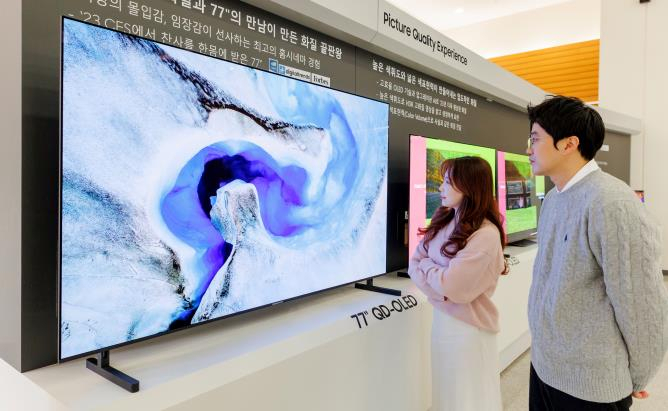 |
Samsung Electronics’ new 77-inch QD-OLED TV (Samsung Display) |
Almost a decade after Samsung Electronics ditched the organic light-emitting diode TV business, the tech giant has returned to the market where crosstown rival LG Electronics dominates almost 60 percent of sales.
Following its global launch last year, Samsung said Monday it would take preorders for its brand-new OLED TV at home, ahead of its official release on March 9.
Samsung debuted 55-inch and 56-inch OLED TVs in Latin America, Oceania and Southeast Asia in March last year, but their Korean launch had been delayed as the company struggled to secure enough panels from its display-making unit Samsung Display.
In Korea, Samsung is releasing a 77-inch model in reflection of consumer demand for bigger-screen TVs.
With the planned launch, Samsung is bracing for its grand comeback to the OLED TV market after a decade-long hiatus, industry sources said.
The company rolled out its first OLED TV -- a 55-inch curved TV with full high-definition capabilities -- in 2013, but announced its withdrawal from the then-nascent market within a year, citing high prices and low yield rates in production.
Since then, the company has poured resources into upgrading its more profitable liquid-crystal display TVs. Its latest LCD TVs are branded as “QLED TVs,” as they use Samsung’s own quantum-dot technology to achieve bright colors and brightness that are comparable to OLED TVs.
For the new OLED TVs, sources say, Samsung Display has elevated yield rates to some 90 percent, making it possible for the tech giant to increase its production volume for a stable supply. Still, the figure is considered low for Samsung to compete head-on with LG, the market leader.
Samsung's QD-OLED panel production rate is estimated to stand at 30,000 pieces per month, which is enough to make 1.8 million QD-OLED TVs in a year at a 100 percent yield. This is only one-fifth of the capacity of LG Display's 10 million units, the sources said.
This discrepancy in production volume is expected to affect the price competitiveness of Samsung TVs.
“Unlike LG and other competitors that are releasing OLED TVs as their top-of-the-line TVs, Samsung set the pricing slightly lower than its LCD-based QLED TVs,” an industry official said on condition of anonymity. “But the lower pricing will not work effectively to increase sales volume if there is not enough supply.”
A Samsung official denied any changes in its premium strategy focused on the high-priced QLED TV lineup.
“Due to the huge popularity in overseas markets, it is true that the supplies of OLED TVs are not enough to meet the domestic demand,” he said. “Our key strategy is offering consumers a wide range of product options with different panel types.”
Despite earlier struggles of Samsung, its return is expected to help expand the overall sales volume of OLED TVs globally.
Global market researcher Omdia predicted that the QD-OLED TV market will grow 141 percent on-year this year, while the overall OLED TV shipments will increase by 9 percent on-year to 7.4 million units.
"LG Electronics' market share in the global OLED TV market stands at around 60 percent. ... With the OLED TV market expected to continue to grow, the global industry will likely pay keen attention to how quickly Samsung can establish itself in a market dominated by LG Electronics," said another industry official who wished to be unnamed.
According to market tracker UBI Research, the panel shipments for OLED TVs around the world will reach 9.1 million units this year and jump to 11.6 million units in 2025 and 14.1 million units in 2027.
And Samsung and LG are estimated to see 2 million and 10 million unit sales by 2025, respectively, the researcher said.
“In order to achieve a combined 20 million unit sales, Samsung and LG have to lower prices to raise their product competitiveness,” said Yi Choong-hoon, CEO of UBI Research.
“But expanding production lines is a tough decision considering the huge costs worth some 3 trillion won ($2.3 billion) at least. Both companies are expected to take a cautious approach to gauge the marketability of premium TVs.”






![[Today’s K-pop] Blackpink’s Jennie, Lisa invited to Coachella as solo acts](http://res.heraldm.com/phpwas/restmb_idxmake.php?idx=644&simg=/content/image/2024/11/21/20241121050099_0.jpg)
